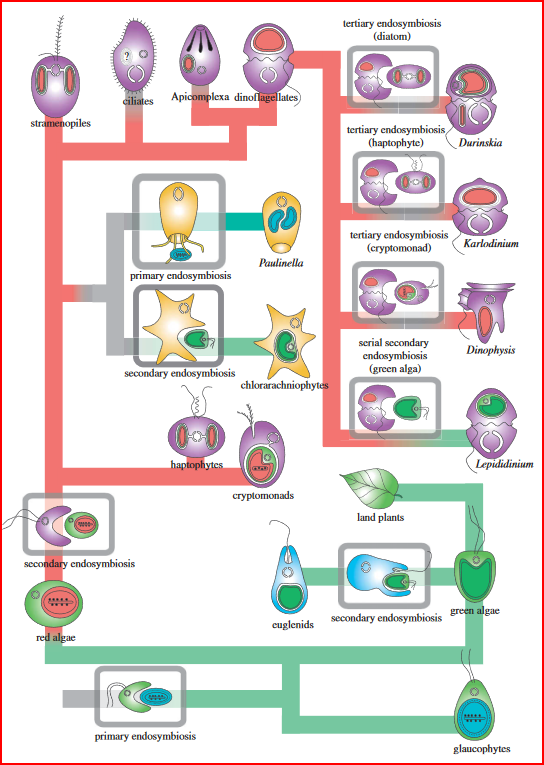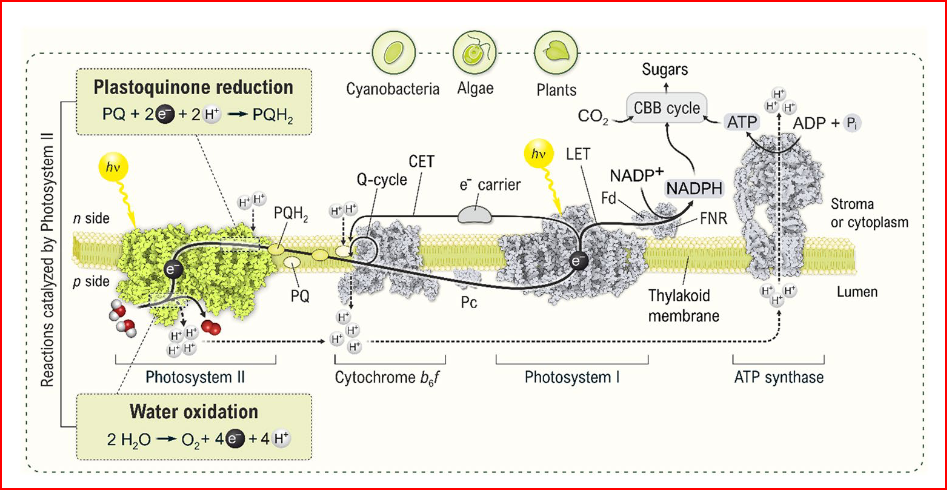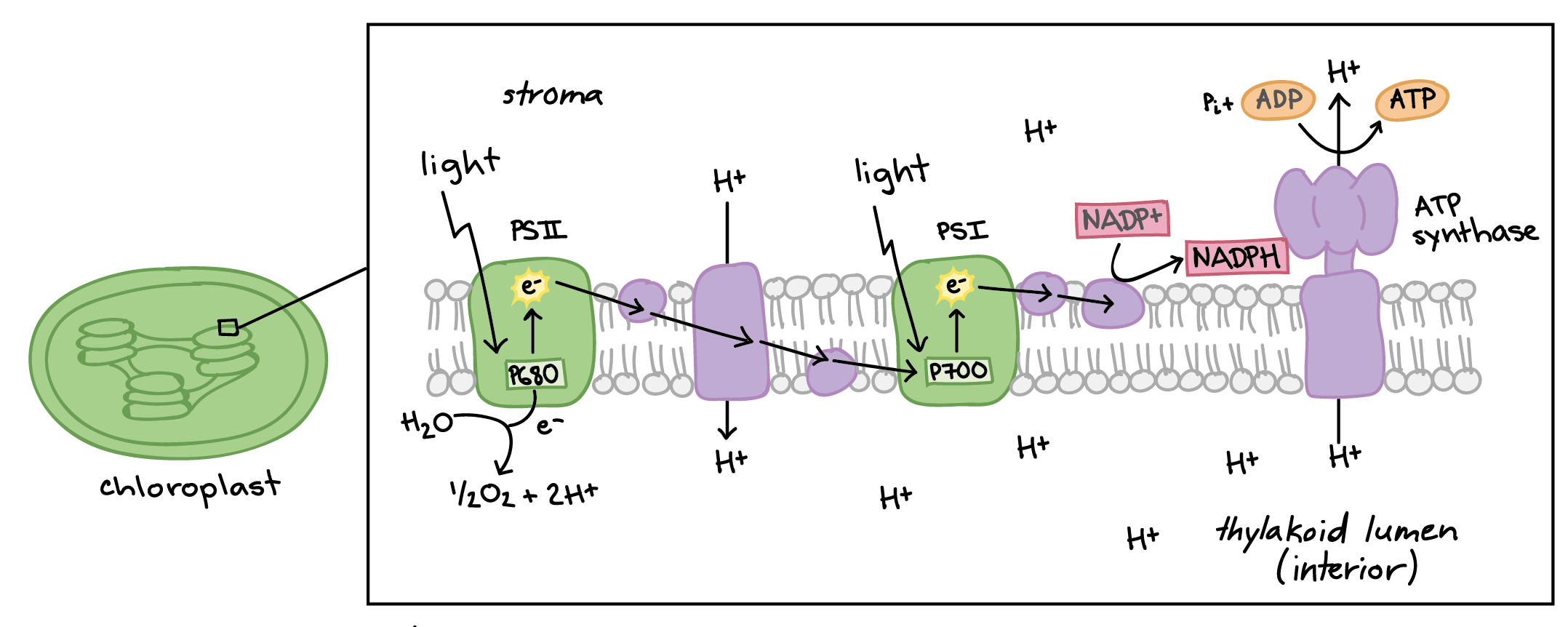if ('tidyverse' %in% rownames(installed.packages()) == 'FALSE') install.packages('tidyverse')library(tidyverse)tribble(
~Abbreviation, ~ Definition,
"ETR", "electron transport rate",
"PSII", "effective quantum yield",
"rETR", "relative electron transport rate",
"PAR", "photosynthetically active radiation",
"ADP", "adeonsine diphosohate",
"ATP", "adenosine triphosphate",
"Chl-a", "chlorophyll-a",
"PSII", "photosystem II") %>%
arrange(Abbreviation)# A tibble: 8 × 2
Abbreviation Definition
<chr> <chr>
1 ADP adeonsine diphosohate
2 ATP adenosine triphosphate
3 Chl-a chlorophyll-a
4 ETR electron transport rate
5 PAR photosynthetically active radiation
6 PSII effective quantum yield
7 PSII photosystem II
8 rETR relative electron transport rate 1 A deep dive in photosynthesis
Photosynthesis is magic. Four proteins embedded in a delicate lipid membrane turn light into sugar. It’s energy transformation! The process by which light energy is transformed into chemical energy (aka sugar energy!). Photosynthesis is the original tool that cyanobacteria used to start the Great Oxygenation Event 2.4 billion years ago.1 It is effectively the only source of molecular oxygen that supports higher life.
1 #wedidn’tstartthefire
“The most important thing as far as astrobiologists are concerned is the fact that there are no known abiotic mechanisms of producing an O2-rich atmosphere. If we find a planet with O2 in its atmosphere, would be forced to conclude that life was the cause. A remarkable 99.9999% of the oxygen in Earth’s atmosphere was produced by life, the tiny remainder being a result of photodissociation of H2O [4].” - New Worlds, University of Colorado, Boulder(“New Worlds” n.d.)
Photosynthesis takes water (H2O), carbon dioxide (CO2), and photons and converts it to glucose (C6H12O6), water and oxygen (O2).
\[ 6CO_2 + 12H_2O + photons \longrightarrow C_6H_{12}O_6 + 6O_2 + 6H_2O \]
The breathable molecular oxygen on Earth today is produced through photosynthesis. The oxygen and sugar molecules that travel through our blood were made by cyanobacteria, algae, and plants. For how important this process is, it’s so often overlooked or skimmed past. In this post, I will take a deep dive. So grab a cup of tea and a sketch pad and take a deep breath. We’re going under!
Photosynthesis occurs in two out of three Domains of life: Bacteria (cyanobacteria, (a.k.a. blue-green algae) & Eukarya (red, brown, & green algae & plants!) Archaea, the third Domain, is made up of a group of single-celled microorganisms that do not photosynthesize. Here, I will focus mostly on the marine endosymbionts that form symbioses with marine invertebrates.
1.1 Primary endosymbiosis
The evolution of the chloroplast can be traced back to when an alphaproteobacterium engulfed a cyanobacterium. This event is called the ‘primary endosymbiosis’ and is illustrated in the diagram below by a green pac-man shape (the alphaproteobacterium) engulfing a blue football-shaped cyanobacterium. Primary endosymbiosis resulted in plastids (here plastids mean chloroplasts and mitochondria) that are bounded by two membranes. The lineage of primary endosymbiosis diverged into three: red algae, green algae, and glaucophytes.
The green algae are thus products of primary endosymbiosis and are characterized by two layers of membranes around their plastids. This includes their chloroplasts.

1.2 Light-dependent reactions in oxygenic photosynthesis
A brief intro to photosynthesis by Khan Academy

1.3 Cyclic electron flow
Finally, cyclic electron flow may play a photoprotective role, preventing excess light from damaging photosystem proteins and promoting repair of light-induced damage
2 How do we measure photosynthesis?
PAM fluorescence measurements analyze the state and turnover of photosystem II reaction centers. Combined with oxygen consumption, we an assess the role of alternative oxygen-processing pathways.
The MINI-PAM-II uses an oxygen optode, the sensor’s responsive element is a luminescent dye whose light emission is quenched by oxygen. The optode measurement does not consume oxygen.
What is fluorescence?
Pulse Amplitude Modulation (PAM) Fluorometers use three different lights to trigger the photosynthetic apparatus and chlorophyll-a molecule.
weak measuring light
saturating pulse
actinic light
3 Don’t forget, photosynthesizers also do respiration!
They don’t just produce oxygen, they also consume it and release carbon dioxide (CO2).
4 Oxygen Measurement with Oxygen Meter FireStingO2 & Fluorescense with MINI-PAM-II
Download the Oxygen Logger software for the FireStingO2 at the legacy downloads site for PyroSciences.
Before connecting the FireStingO2 to the Walz Mini-PAM II, you need to configure the software to the particular oxygen optode sensor used. Anytime you download new software, or switch sensors, you will need to do this step. For this, you only need the FireStingO2, the oxygen optode sensor you will be using, and the micro-USB cable that connects the FireStingO2 to a computer with Oxygen Logger software installed.
The insertion of the interface plug disables USB communication via the Micro-USB port. To change settings of the FireStingO2 oxymeter via USB connection by the Oxygen Logger software, the interface plug must be removed.
